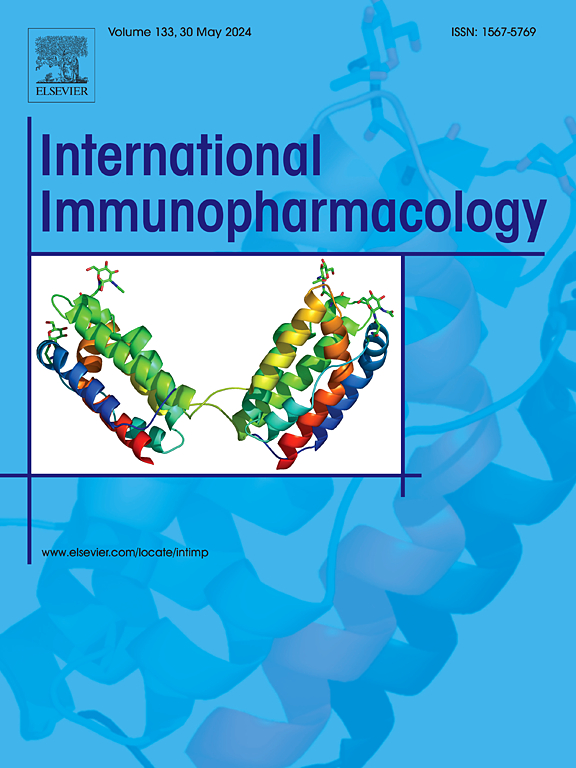双功能抑制剂CYT-1协同抑制焦亡以改善糖尿病脑病的认知功能障碍
IF 4.7
2区 医学
Q2 IMMUNOLOGY
引用次数: 0
摘要
糖尿病性脑病(DE)是糖尿病的重要并发症,主要表现为认知障碍。焦亡介导的神经元焦亡是糖尿病诱导认知功能障碍的关键因素。研究表明,使用NLRP3抑制剂阻断NLRP3炎性体激活或使用H2S抑制NF-κB激活可减少DE小鼠焦亡,改善认知功能障碍。本研究旨在设计一种同时抑制NLRP3和NF-κB激活的双功能化合物,协同抑制神经元焦亡,用于临床治疗DE。本研究报道了新型化合物CYT-1,该化合物在体外显著降低焦亡途径蛋白(p-NF-κB、NLRP3、Caspase-1和GSDMD-N)和炎症因子(IL-1β和IL-18)的水平。CYT-1显著增加DE小鼠血清和海马中H2S浓度,Western blotting和Nissl染色表明,CYT-1显著降低体内热死相关蛋白水平,增加海马神经元计数。研究结果表明,CYT-1通过同时抑制NF-κB活化和NLRP3炎性体活性,协同抑制神经元焦亡。本研究可能为DE的药物研究和临床治疗提供新的思路。本文章由计算机程序翻译,如有差异,请以英文原文为准。

A bifunctional inhibitor CYT-1 synergistically suppresses pyroptosis to improve cognitive dysfunction in diabetic encephalopathy
Diabetic encephalopathy (DE) is a significant complication of diabetes mellitus, primarily characterized by cognitive impairment. Pyroptosis-mediated neuronal pyroptosis is a key factor in diabetes-induced cognitive dysfunction. Research indicates that using NLRP3 inhibitors to block NLRP3 inflammasome activation or employing H2S to inhibit NF-κB activation can decrease pyroptosis and improve cognitive dysfunction in DE mice. Here, our aim is to design a bifunctional compound that can simultaneously inhibit the activation of NLRP3 and NF-κB to synergistically suppress neuronal pyroptosis for the clinical treatment of DE. This study reports the novel compound CYT-1, which significantly reduces levels of pyroptosis pathway proteins (p-NF-κB, NLRP3, Caspase-1, and GSDMD-N) and inflammatory factors (IL-1β and IL-18) in vitro. CYT-1 markedly increases H2S concentrations in both the serum and hippocampus of mice with DE. Western blotting and Nissl staining demonstrated that CYT-1 notably decreased pyroptosis-related protein levels and enhanced hippocampal neuron counts in vivo. The findings demonstrate that CYT-1 synergistically inhibits neuronal pyroptosis by concurrently suppressing NF-κB activation and NLRP3 inflammasome activity. This study may provide new ideas for drug research and clinical treatment of DE.
求助全文
通过发布文献求助,成功后即可免费获取论文全文。
去求助
来源期刊
CiteScore
8.40
自引率
3.60%
发文量
935
审稿时长
53 days
期刊介绍:
International Immunopharmacology is the primary vehicle for the publication of original research papers pertinent to the overlapping areas of immunology, pharmacology, cytokine biology, immunotherapy, immunopathology and immunotoxicology. Review articles that encompass these subjects are also welcome.
The subject material appropriate for submission includes:
• Clinical studies employing immunotherapy of any type including the use of: bacterial and chemical agents; thymic hormones, interferon, lymphokines, etc., in transplantation and diseases such as cancer, immunodeficiency, chronic infection and allergic, inflammatory or autoimmune disorders.
• Studies on the mechanisms of action of these agents for specific parameters of immune competence as well as the overall clinical state.
• Pre-clinical animal studies and in vitro studies on mechanisms of action with immunopotentiators, immunomodulators, immunoadjuvants and other pharmacological agents active on cells participating in immune or allergic responses.
• Pharmacological compounds, microbial products and toxicological agents that affect the lymphoid system, and their mechanisms of action.
• Agents that activate genes or modify transcription and translation within the immune response.
• Substances activated, generated, or released through immunologic or related pathways that are pharmacologically active.
• Production, function and regulation of cytokines and their receptors.
• Classical pharmacological studies on the effects of chemokines and bioactive factors released during immunological reactions.

 求助内容:
求助内容: 应助结果提醒方式:
应助结果提醒方式:


